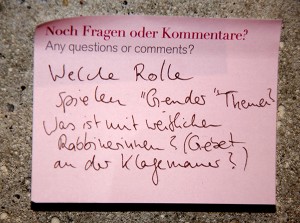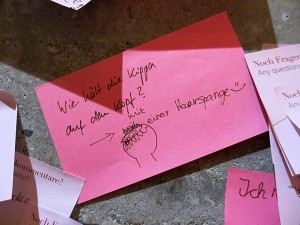“What’s the story with women rabbis? (And prayer at the Western Wall?)”

The question of the month in the special exhibition “The Whole Truth”
© Jewish Museum Berlin, photo: Anina Falasca
Our special exhibition “The Whole Truth… everything you always wanted to know about Jews” is based on 30 questions posed to the Jewish Museum Berlin or its staff over the past few years. In the exhibition, visitors have their own opportunity to ask questions or to leave comments on post-it notes. We answer some of these questions here in our blog.
The question about the roles of men and women in Judaism is interesting because traditional notions about these roles have changed dramatically over the course of the last century. As in every religion, there are also many opinions about this issue among Jews. These correspond with the tendencies of orthodox, conservative, or liberal currents in Judaism, which – while they grapple with the same questions – come to quite different conclusions. → continue reading
“Why do some Jews rock back and forth while they pray?”
Our special exhibition “The Whole Truth… everything you always wanted to know about Jews” is based on 30 questions posed to the Jewish Museum Berlin or its staff over the past few years. In the exhibition, visitors have their own opportunity to ask questions or to leave comments on post-it notes. Some of these questions will be answered here in our blog, such as last month’s query: “how does a kippah stay on?” This month, we respond to Boris, who wants to know “why some Jews rock back and forth while they pray?”

“Why do some Jews rock back and forth while they pray? Boris”
© photo: Thomas Valentin Harb, Jewish Museum Berlin
Dear Boris,
Many people have asked why religious Jews sway back and forth while praying. This very old custom is called shuckling in Yiddish and means to rock, shake, or swing. As with many customs, it is easier to describe when and where it was practiced, than to answer definitively, why people shuckle while praying and studying the Torah. → continue reading
“How does a kippah stay on?”
Our current special exhibition “The Whole Truth… everything you always wanted to know about Jews” is based on 30 questions posed to the Jewish Museum Berlin or its staff over the past few years. In the exhibition, visitors have their own opportunity to ask questions or to leave comments on post-it notes. Some of these questions will be answered here in our blog. This month’s question is: “How does a kippah stay on?”

“How does a kippah stay on?”
© photo: Anina Falasca, Jewish Museum Berlin
If a non-Jew tries on a kippah, it usually falls off. This isn’t fair, but let’s examine the circumstances more closely. When tourists visit the Jewish cemetery in Prague, all men are asked to wear a kippah. Those who travel kippah-free are requested to don a blue, sharply-creased, circular piece of paper. The precarious kippah is inevitably subjected to the winds off the Vltava and flutters away. Comparably, a non-Jewish man attending a synagogue ceremony such as a marriage or Bar Mitzvah, will usually be requested to wear a kippah. Here, a stiff yet slippery synthetic satin kippah is ubiquitous. No guest stands a chance.
What then is the secret to making a kippah stay on? → continue reading


